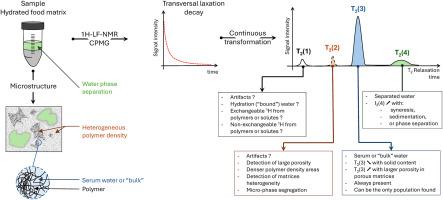利用质子低频核磁共振(LF-NMR)揭示不同食物基质中的微观结构和水行为:具体看1H-LF-NMR结果解释
IF 11
1区 农林科学
Q1 CHEMISTRY, APPLIED
引用次数: 0
摘要
质子低频核磁共振(1H-LF-NMR)已成为研究食物基质中水迁移率的首选方法。它已应用于各种复杂的基质,如蔗糖溶液和复杂的水胶体混合体系。利用carr - purcell - meiboomm - gill扫描序列测量自旋-自旋弛豫时间(T2),通常用于研究弛豫时间较长的水合基质(>1ms)。研究报告了1 - 4种水种群,其中包括“结合水”、血清中的散装水和分离水(沉淀、协同作用)。我们团队在不同食物系统上的实验和文献结果将用于演示1H-LF-NMR如何探测食物微观结构以及避免伪影所需的护理。以发酵乳、混合多糖、混合蛋白-多糖体系和豆粕为例。尽管不同基质的类型(悬浮液、凝胶等)、组成和微观结构不同,但它们之间的水迁移模式相似。例如,在酸奶配方中,血清水分流动性与网络异质性相关。血清水通常是研究中最受关注的,因为它可以受到血清溶质、血清粘度和凝胶微观结构(孔隙度、大分子密度)的影响。然而,水的流动性也能够检测和量化自发血清分离或检测由于分离相互作用引起的微观结构异质性。当与用于微观结构表征的其他方法相结合时,h - lf - nmr可以探测模型和复杂食物系统中的水相互作用。通过揭示水在食物基质中的相互作用,这种方法是一种强大、简单、非破坏性的工具,可以了解大分子相互作用及其组织。本文章由计算机程序翻译,如有差异,请以英文原文为准。

Unraveling microstructure and water behavior in diverse food matrices using low-frequency NMR (LF-NMR) on proton: a specific look at 1H-LF-NMR results interpretation
Low-frequency NMR on proton (1H-LF-NMR) has become a method of choice to study water mobility in food matrices. It has been applied on matrices varying in complexity such as sucrose solutions and complex hydrocolloid mixed systems. Measurements of spin-spin relaxation time (T2) using Carr-Purcell-Meiboom-Gill scan sequences are often used to study hydrated matrices with long relaxation times (>1ms). Studies reported 1 to 4 water populations among which “bound water”, bulk water from serum, and separated water (sedimentation, syneresis).
Experiments from our team on different food systems and results from the literature will be used to demonstrate how 1H-LF-NMR can probe food microstructure and the care needed to avoid artifacts. Examples were taken among fermented milk, mixed polysaccharides, mixed protein-polysaccharide systems and legume purée. Water mobility shows similar patterns between these different matrices even though their type (suspension, gel, …), composition and microstructure are different in nature. For instance, in yogurt formulations the serum water mobility correlated with network heterogeneity. The serum water often gets most of the attention in studies as it can be affected by serum solutes, serum viscosity, and gel microstructure (porosity, macromolecular density). However, water mobility was also able to detect and quantify spontaneous serum separation or to detect microstructural heterogeneity due to segregative interactions.
1H-LF-NMR when combined with other methods used for microstructure characterization allows to probe water interactions in both model and complex food systems. By revealing water interactions in food matrices, this method is a powerful, simple, and non-destructive tool to inform on macromolecular interactions and their organization.
求助全文
通过发布文献求助,成功后即可免费获取论文全文。
去求助
来源期刊

Food Hydrocolloids
工程技术-食品科技
CiteScore
19.90
自引率
14.00%
发文量
871
审稿时长
37 days
期刊介绍:
Food Hydrocolloids publishes original and innovative research focused on the characterization, functional properties, and applications of hydrocolloid materials used in food products. These hydrocolloids, defined as polysaccharides and proteins of commercial importance, are added to control aspects such as texture, stability, rheology, and sensory properties. The research's primary emphasis should be on the hydrocolloids themselves, with thorough descriptions of their source, nature, and physicochemical characteristics. Manuscripts are expected to clearly outline specific aims and objectives, include a fundamental discussion of research findings at the molecular level, and address the significance of the results. Studies on hydrocolloids in complex formulations should concentrate on their overall properties and mechanisms of action, while simple formulation development studies may not be considered for publication.
The main areas of interest are:
-Chemical and physicochemical characterisation
Thermal properties including glass transitions and conformational changes-
Rheological properties including viscosity, viscoelastic properties and gelation behaviour-
The influence on organoleptic properties-
Interfacial properties including stabilisation of dispersions, emulsions and foams-
Film forming properties with application to edible films and active packaging-
Encapsulation and controlled release of active compounds-
The influence on health including their role as dietary fibre-
Manipulation of hydrocolloid structure and functionality through chemical, biochemical and physical processes-
New hydrocolloids and hydrocolloid sources of commercial potential.
The Journal also publishes Review articles that provide an overview of the latest developments in topics of specific interest to researchers in this field of activity.
 求助内容:
求助内容: 应助结果提醒方式:
应助结果提醒方式:


